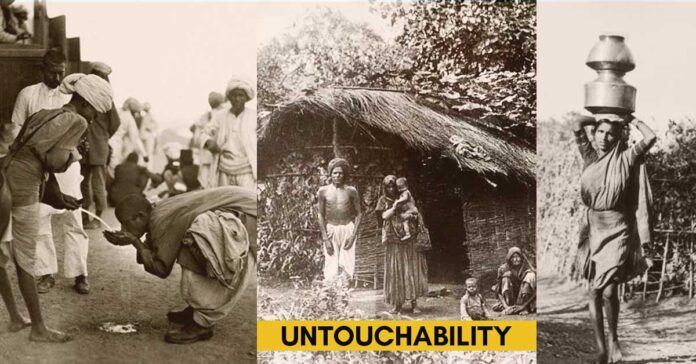Untouchability refers to the practise of discriminating against individuals and groups based on their caste and occupation. Although similar types of discrimination exist around the world, caste-based untouchability is mostly peculiar to South Asia.
Meaning
The word is most usually connected with the treatment of “polluting” Dalit populations in the Indian subcontinent. Other groups that have used the title include the Burakumin of Japan, the Baekjeong of Korea, and the Ragyabpa of Tibet, as well as the Romani and Cagot of Europe and the Al-Akhdam of Yemen.
Interestingly, it is based on the caste system of India. Because of their inferior caste position, untouchables are regularly subjected to inhumane treatment. They have been subjected to various sorts of prejudice in practically every area.
Dalits are untouchables, and the term Dalit is derived from the Sanskrit word for damaged or humiliated. The widely held assumption that untouchability exists exclusively in India is incorrect; it also persists in Japan, Tibet, and Korea.
Mostly heard behaviour we get to hear in India are:
- Denying them fundamental human rights.
- Interfering with anyone’s attendance or prayer at a public place of worship
- Refusal to enter any retail establishment, hotel, nightclub, or other public entertainment place
- Restrictions on the site of public utilities such as a reservoir, a tap, or other water sources, a road, a public pasture, or a cremation.
- Refusal to accept persons to hospitals, educational institutions, or public-benefit hostels
- Refusing to sell or provide services to anyone
- Expecting them to do demeaning tasks such as sewage cleaning and shoe washing.
4 Varnas
While Hindus these days claim that they have only 4 varnas, in which Dalit was not described in varnas. All 3 varnas are addressed with the same name, why is only ‘shudra’ addressed by the term Dalit? They say that untouchability was never in their scriptures. 4 varnas describe the nature of humans and occupations. If practices happened based on occupation at some point of time, that is a human problem, not religion. They also claim that this is colonial invention.
Statistics from 19th century
Famous Indian writer Dhrampal, set statistics from 19th century during the British occupation of India. He compiled statistics about the ancient Indian pre premaclian indigenous education system. He read the books and letters written to the Britishers by the British citizens who came to India to give statistics. Even today, the book is read to know the truth.
B.R. Ambedkar
They also blame people like Dr. Bhim Rao Ambedkar for burning Manusmrithi because in Parashar Smriti it is clearly written that Manu Smrithi is not for kaliyug but for satya yug. But only because of a practical person like Dr. Bhim Rao Ambedka Indians got real freedom.
Akhanda Bharath
They believe in Akanda Bharath, which is not from kashmir to kanyakumari but from the land right from the Himalayas to southern Asia is India. So no wonder why Japan, Tibet, and Korea also have untouchability. While this is what Hindus claim, several people from many centuries suffered and still continue to date.
However, through our research we got to know that Asian countries like Japan, Tibet, and Korea also have untouchability on the basis of their occupations like executioners, butchers and undertakers.
Earlier, it was recommended to stay away from these people because of their occupation. As the job demands them to work in the dirt, blood and they carry bacteria which cannot be seen with the naked eye.
ALSO READ: Viral video: Dalit woman assaulted by temple administration Board member


